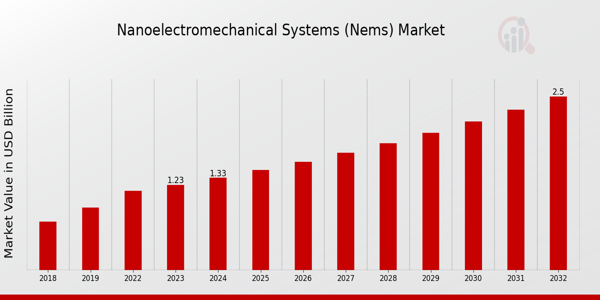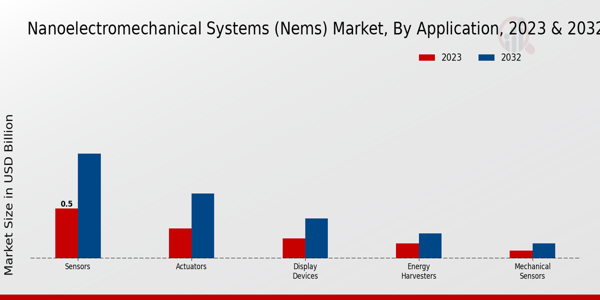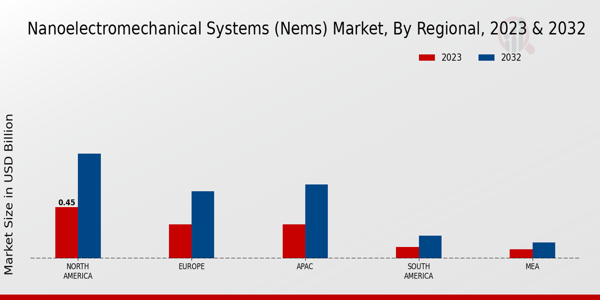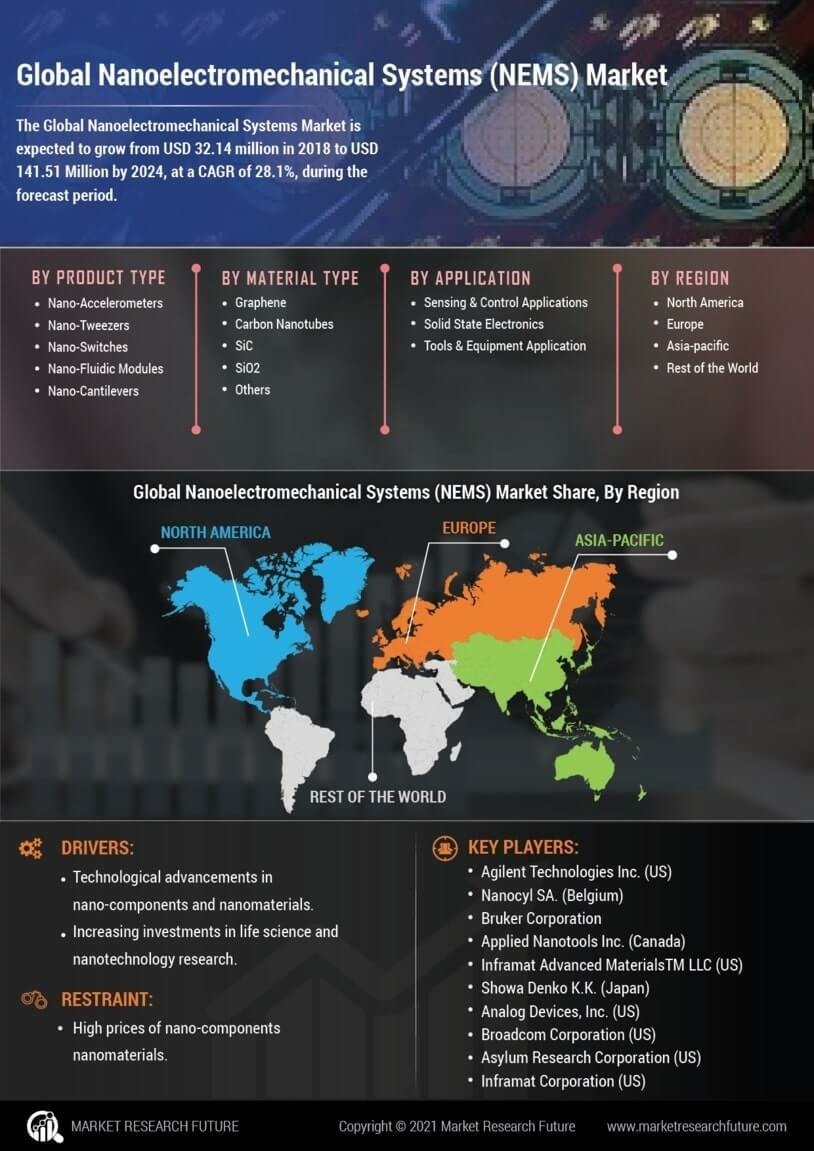Global Nanoelectromechanical Systems (NEMS) Market Overview:
The Nanoelectromechanical Systems (NEMS) Market Size was estimated at 1.14 (USD Billion) in 2022. The Nanoelectromechanical Systems (NEMS) Market Industry is expected to grow from 1.23(USD Billion) in 2023 to 2.5 (USD Billion) by 2032. The Nanoelectromechanical Systems (NEMS) Market CAGR (growth rate) is expected to be around 8.18% during the forecast period (2024 - 2032).
Key Nanoelectromechanical Systems (NEMS) Market Trends Highlighted
The Nanoelectromechanical Systems (NEMS) Market is evolving comprehensively owing to a number of factors. The trend towards miniaturization of electronic devices and components is driving many industries towards NEMS that is in smaller size yet better performing. In addition, the progress in the field of nanotechnology has improved the fabrication processes and made the integration of NEMS into the existing systems easier. The growth of the market is also propelled by the rising demand for devices that consume less energy since NEMS devices are low in power and high in sensitivity.
In addition, the growing range of potential applications of NEMS in health care, telecommunications and automotive sectors is enhancing the investment and innovation in this area.
Prospects in the NEMS market are quite a lot. Definitely, new possibilities open for expansion as the capacity to create intelligent materials and flexible electronics grows, so addressing research and development efforts is critical for companies. In addition, joint ventures of universities and practical enterprises may enable overcoming some of the existing barriers. Another wave of technologies that can be exploited are the applications of the growing Internet of Things (IoT), since the NEMS can be used to improve the communication and capabilities of IoT devices.
Startups oriented on smaller applications like sensing and energy harvesting may occupy niches in the market and therefore help expand the growth of the industry in general.
Market outlook suggests that adoption of NEMS in consumer electronic products is on the rise. There are more expectations on embedding NEMS in mobile phones, wearables and domestic automation systems. Such a trend is due to the quest for accuracy and better live experiences. Furthermore, there is a growing trend towards environmental protection which also calls for the use of green materials and green manufacturing processes in NEMS.
And as the industry begins to understand the advantages of NEMS, there will be continuous replacement, change and investment which means that this technology will be one of the key areas for development. It becomes plausible that the application of Artificial Intelligence towards NEMS can also enhance their functionality making it a crucial line of convergence of technologies in the marketplace.

Source: Primary Research, Secondary Research, MRFR Database and Analyst Review
Nanoelectromechanical Systems (NEMS) Market Drivers
Increasing Demand for Miniaturized Devices
The Nanoelectromechanical Systems (NEMS) Market is experiencing significant growth driven by the increasing demand for miniaturized devices across various industries. As technology progresses, there is a growing necessity for smaller, lighter, and more efficient components that can enhance performance without compromising on functionality. The miniaturization trend is vital for sectors such as consumer electronics, automotive, healthcare, and telecommunications, where space constraints and the demand for portability are paramount.NEMS technology offers unique advantages over traditional mechanical systems due to its small size and improved performance characteristics, such as enhanced sensitivity, faster response times, and lower power consumption.
This is particularly important in applications such as sensing and actuating, where precision and efficiency are crucial. As the demand for such miniaturized solutions continues to rise, it is expected to propel the growth of the Nanoelectromechanical Systems (NEMS) Market Industry in the coming years.Furthermore, the integration of these systems into smaller devices has been facilitated by advancements in fabrication techniques, which are making it easier to develop and mass-produce NEMS devices. Businesses are increasingly adopting NEMS technology not only to optimize performance but also to gain a competitive edge in an ever-evolving market landscape.
Therefore, the emphasis on miniaturization and the need for more compact technology is a significant driver of the NEMS market, contributing to its continued expansion.
Growing Adoption in Healthcare Applications
The healthcare sector is increasingly adopting nanoelectromechanical systems (NEMS) due to their exceptional capabilities in diagnostics, monitoring, and treatment. NEMS devices can offer highly sensitive detection systems that are vital for early disease diagnosis, personalized medicine, and monitoring health conditions with real-time data. As the Nanoelectromechanical Systems (NEMS) Market Industry continues to innovate within the healthcare space, the ability to integrate these systems into medical devices is becoming crucial for improving patient outcomes.This trend is expected to drive growth in the Nanoelectromechanical Systems (NEMS) Market significantly.
Rising Investment in Research and Development
There is a noticeable increase in investment in the research and development of nanoelectromechanical systems (NEMS) technologies in various sectors, which is further propelling market growth. Collaboration between academic institutions, research organizations, and industrial players is fostering innovation, leading to new applications and improved designs of NEMS devices. As companies and governments prioritize technological advancements, the Nanoelectromechanical Systems (NEMS) Market Industry is positioned to benefit from enhanced funding and resources aimed at breakthrough developments.
Nanoelectromechanical Systems (NEMS) Market Segment Insights:
Nanoelectromechanical Systems (NEMS) Market Application Insights
The Nanoelectromechanical Systems (NEMS) Market, specifically within the Application segment, shows a diverse range of functions that are set to drive significant revenue growth. In 2023, the market for this segment is valued at approximately 1.23 USD Billion, reflecting a robust interest in technologies that leverage nanoscale mechanical and electrical processes. The primary areas of application include Sensors, Actuators, Display Devices, Energy Harvesters, and Mechanical Sensors, each of which plays a pivotal role in advancing technology across various sectors.
Among these, the Sensors application has carved out a substantial position, with a valuation of 0.5 USD Billion in 2023, projected to rise to 1.05 USD Billion by 2032, indicating a considerable demand for precision measurement and data acquisition in industries ranging from healthcare to automotive. The significance of Sensors is underscored by their integration into smart systems, enhancing functionality and operational efficiency.
Following closely is the Actuators application, which holds a value of 0.3 USD Billion in 2023 and is expected to grow to 0.65 USD Billion by 2032. Actuators are critical for systems requiring motion control, making them essential in robotics and automated processes, thus justifying their growing market presence. The Display Devices application, valued at 0.2 USD Billion in 2023 and anticipated to reach 0.4 USD Billion in 2032, capitalizes on advancements in miniature optoelectronics, vital for developing advanced screens and visual technology, enriching user experiences in consumer electronics.
Energy Harvesters, while currently valued at 0.15 USD Billion in 2023 with a forecast of 0.25 USD Billion in 2032, represents an emerging opportunity in sustainable technology. This segment focuses on capturing ambient energy, thereby offering solutions aligned with the global push toward energy efficiency and sustainability. Lastly, the Mechanical Sensors application, valued at 0.08 USD Billion in 2023 and projected to grow to 0.15 USD Billion by 2032, complements the overall market ethos by providing reliable measurements of mechanical systems, essential for safety and performance monitoring in various domains.
Collectively, these applications within the Nanoelectromechanical Systems (NEMS) Market signify a transformative shift toward miniaturization and enhanced functionality, driven by robust market data and trends toward smart and efficient technologies, presenting broad opportunities for growth and innovation across multiple sectors.

Source: Primary Research, Secondary Research, MRFR Database and Analyst Review
Nanoelectromechanical Systems (NEMS) Market Material Type Insights
The Nanoelectromechanical Systems (NEMS) Market has gained significant traction with a notable shift in focus towards the Material Type segment. In 2023, the market reached a valuation of 1.23 billion USD, reflecting substantial investment and interest in advanced materials such as Carbon Nanotubes, Silicon-based Materials, Polymers, Metals, and Nanocomposites. Carbon Nanotubes have emerged as a crucial component due to their exceptional mechanical, electrical, and thermal properties, which position them prominently in applications like sensors and actuators.Silicon-based Materials continue to dominate owing to their established role in semiconductor technology, driving innovation in microelectromechanical systems.
Polymers offer flexibility and lightweight advantages, making them vital for consumer electronics and automotive applications. Metals, while traditional, play an essential role in stability and conductivity, particularly in high-performance devices. Nanocomposites are recognized for their ability to enhance material properties significantly, providing opportunities for growth in various industries.Overall, the Nanoelectromechanical Systems (NEMS) Market segmentation indicates a diverse and evolving landscape, poised for steady market growth driven by technological advancements and increasing demand across multiple sectors.
Nanoelectromechanical Systems (NEMS) Market End Use Industry Insights
The Nanoelectromechanical Systems (NEMS) Market exhibits robust growth, with a projected valuation of 1.23 billion USD in 2023, expected to reach approximately 2.5 billion USD by 2032. Within the End Use Industry, the market showcases diverse applications across various sectors, particularly in Consumer Electronics, Automotive, Aerospace, Healthcare, and Telecommunications. Consumer electronics represent a significant portion of the market, driven by the demand for miniaturized components in devices such as smartphones and wearables.
The automotive sector is increasingly adopting NEMS technologies for enhanced sensor systems, contributing to the growth of smart vehicles.Aerospace applications leverage NEMS for precision instrumentation and reliability in harsh environments. In Healthcare, NEMS advancements are vital for developments in medical devices that require miniaturization and enhanced functionality. Telecommunications also benefits as NEMS supports the evolution of high-speed communication and connectivity. The market growth is propelled by technological advancements and increasing demand for compact, efficient systems.
However, challenges such as high production costs and the complexity of integrating NEMS into existing technologies persist.Overall, the Nanoelectromechanical Systems (NEMS) Market revenue is set for significant expansion, reflecting the broader trend towards miniaturization and efficiency across industries.
Nanoelectromechanical Systems (NEMS) Market Processing Technology Insights
The Nanoelectromechanical Systems (NEMS) Market, particularly the Processing Technology segment, is poised for notable growth as industries increasingly adopt advanced manufacturing techniques. This segment comprises various methodologies, including Top-down Lithography, which plays a crucial role in producing intricate structures with high precision. Bottom-up Assembly is significant for its ability to construct nanoscale components from molecular units, enhancing efficiency in fabrication. Nanoimprint Lithography has emerged as a key technology because of its cost-effectiveness and high throughput for large-scale productions.Microfabrication techniques also hold importance, enabling the creation of complex geometries essential for various applications.
Self-assembly processes are recognized for their potential in developing self-organizing structures, pushing the boundaries of conventional manufacturing. As per the Nanoelectromechanical Systems (NEMS) Market statistics, this segment is expected to drive substantial revenue growth, reflecting the ongoing trends toward miniaturization and automation in diverse industries, thus showcasing a blend of opportunities and challenges that industry players need to navigate.
Nanoelectromechanical Systems (NEMS) Market Regional Insights
In 2023, the Nanoelectromechanical Systems (NEMS) Market is valued at 1.23 USD Billion. Regionally, North America holds a significant share of the market, being valued at 0.45 USD Billion, which indicates its majority holding within the industry due to advanced technological infrastructure and high investments in research and development. Europe follows, valued at 0.3 USD Billion, where growing applications across various sectors drive demand.
The Asia-Pacific (APAC) region shows promising growth, also valued at 0.3 USD Billion, benefitting from rapid industrialization and a rising emphasis on nanotechnology in electronics.South America and the Middle East Africa (MEA) show comparatively smaller valuations, at 0.1 USD Billion and 0.08 USD Billion respectively, reflecting emerging markets with potential for growth. The presence of diverse end-user industries and increasing innovation in nanotechnology within North America and APAC contributes significantly to the overall Nanoelectromechanical Systems (NEMS) Market data, presenting opportunities for expansion in these regions.
Each regional market demonstrates unique growth drivers such as technological advancements and evolving consumer preferences that shape the market landscape.

Source: Primary Research, Secondary Research, MRFR Database and Analyst Review
Nanoelectromechanical Systems (NEMS) Market Key Players and Competitive Insights:
The Nanoelectromechanical Systems (NEMS) Market is characterized by rapid advancements in technology and an increasing demand for miniaturization across various applications. This market has gained momentum due to its pivotal role in enhancing sensitivity and performance in numerous fields, including sensing, MEMS devices, and biomedical applications. The competitive landscape is shaped by a variety of players involved in research, development, and commercialization of NEMS technologies. Companies are focusing on innovation, mergers and acquisitions, strategic collaborations, and expanding their geographical presence to strengthen their positions.
With the growing integration of NEMS into consumer electronics and industrial applications, understanding the competitive dynamics becomes crucial for stakeholders, as they strive to leverage the unique advantages presented by NEMS technology.Harvard University stands out in the Nanoelectromechanical Systems (NEMS) Market due to its robust research capabilities and a rich history of innovative engineering practices. The institution consistently attracts renowned faculty and researchers who contribute to pioneering advancements in nanotechnology and its applications. Harvard University’s access to state-of-the-art facilities and interdisciplinary collaboration enables the development of cutting-edge nanoscale devices that show promising results in performance efficiency and reliability.
The university has fostered strong partnerships with industry leaders, bridging the gap between theoretical research and practical implementations of NEMS technologies. Additionally, its deep focus on fostering entrepreneurial initiatives further propels the commercial potential of established NEMS innovations, ensuring Harvard remains a significant player in this evolving market.Stanford University also plays a crucial role in the Nanoelectromechanical Systems (NEMS) Market, characterized by its strong emphasis on interdisciplinary research and collaboration across various engineering and science departments.
The university has been pivotal in the development of novel NEMS applications, with a focus on improving functionality and exploring new capabilities in sensors and actuators. Stanford’s commitment to innovation is reflected in its investment in cutting-edge research facilities and technology incubators that facilitate the translation of ideas from laboratory to market. As a hub for scientific and technological advancements, Stanford University attracts talented researchers and students, further enhancing its competitive edge in the NEMS landscape.
The diverse expertise and robust research output allow for advancements that not only meet current market demands but also shape the future of NEMS technology.
Key Companies in the Nanoelectromechanical Systems (NEMS) Market Include:
Nanoelectromechanical Systems (NEMS) Market Industry Developments
Recent developments in the Nanoelectromechanical Systems (NEMS) Market highlight significant advancements and collaborations among key players. Harvard University and Stanford University continue to push the boundaries of research in NEMS technology, focusing on applications in sensing and actuators. Analog Devices and MIT are working closely on integrating advanced NEMS devices for enhanced performance in electronic systems. Meanwhile, Nanosys and NIST are engaged in developing nanostructured materials to improve system efficiency. Vanderbilt University and Cypress Semiconductor are reporting growth in NEMS applications for medical diagnostics, indicating a rising market demand.
Texas Instruments and IBM are exploring merger and acquisition opportunities to consolidate their capabilities in NEMS research and development, aiming to enhance product portfolios and drive innovation in nanoscale devices. Companies are experiencing substantial market valuation increases, influenced by the rising demand for miniaturized sensing technologies and smart materials, further enhancing the competitive landscape. As universities and corporations collaborate, the potential applications of NEMS in various industries such as healthcare, automotive, and consumer electronics are expanding, reshaping the market dynamics and fostering a robust growth trajectory.
Nanoelectromechanical Systems (NEMS) Market Segmentation Insights
Nanoelectromechanical Systems (NEMS) Market Application Outlook
Nanoelectromechanical Systems (NEMS) Market Material Type Outlook
Nanoelectromechanical Systems (NEMS) Market End Use Industry Outlook
Nanoelectromechanical Systems (NEMS) Market Processing Technology Outlook
Nanoelectromechanical Systems (NEMS) Market Regional Outlook
|
Report Attribute/Metric
|
Details
|
|
Market Size 2022
|
1.14 (USD Billion)
|
|
Market Size 2023
|
1.23 (USD Billion)
|
|
Market Size 2032
|
2.5 (USD Billion)
|
|
Compound Annual Growth Rate (CAGR)
|
8.18% (2024 - 2032)
|
|
Report Coverage
|
Revenue Forecast, Competitive Landscape, Growth Factors, and Trends
|
|
Base Year
|
2023
|
|
Market Forecast Period
|
2024 - 2032
|
|
Historical Data
|
2019 - 2023
|
|
Market Forecast Units
|
USD Billion
|
|
Key Companies Profiled
|
Harvard University, Stanford University, Analog Devices, MIT, Nanosys, NIST, Vanderbilt University, Cypress Semiconductor, Texas Instruments, IBM, Duke University, Queens University, University of California, Sensors and Control Technologies, Northwestern University
|
|
Segments Covered
|
Application, Material Type, End Use Industry, Processing Technology, Regional
|
|
Key Market Opportunities
|
Miniaturization in consumer electronics, Advancements in medical devices, Smart sensors for IoT applications, Enhanced energy harvesting solutions, Integration in automotive technologies
|
|
Key Market Dynamics
|
Miniaturization of devices, Increasing demand for sensors, Advancements in fabrication technologies, Growing applications in healthcare, Rising investments in research and development
|
|
Countries Covered
|
North America, Europe, APAC, South America, MEA
|
Nanoelectromechanical Systems Market Highlights:
Frequently Asked Questions (FAQ):
The market is expected to be valued at 2.5 USD Billion in 2032.
The expected CAGR for the market is 8.18% from 2024 to 2032.
The Sensors application segment is projected to dominate the market with a value of 1.05 USD Billion in 2032.
The market value for Actuators in 2023 was 0.3 USD Billion.
North America is anticipated to have the highest market value at 0.92 USD Billion in 2032.
The Energy Harvesters segment is expected to grow to 0.25 USD Billion by 2032.
Major players in the market include Harvard University, Stanford University, and IBM among others.
The market value for Europe is expected to be 0.59 USD Billion in 2032.
Some challenges include technological complexity and the high cost of production.
The Mechanical Sensors segment is expected to be valued at 0.15 USD Billion in 2032.


















